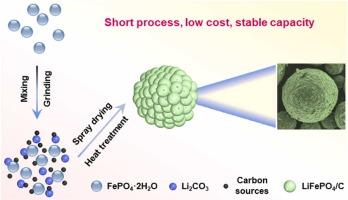碳源对含水FePO4制备LiFePO4微球的微观结构和性能的影响
IF 6.3
2区 材料科学
Q2 CHEMISTRY, PHYSICAL
引用次数: 0
摘要
磷酸铁锂(LiFePO4, LFP)由于其低成本、优异的长期循环稳定性和强大的热弹性,在社会各个领域得到了广泛的应用。然而,以无水磷酸铁(FePO4, FP)为原料制备LFP的传统方法存在成本高、工艺长等问题。因此,迫切需要开发具有成本效益的短工艺路线来生产LFP。本研究以含水FP为铁源和磷源,考察不同分解温度下碳源对产物组成、形貌和电化学行为的影响。结果表明,以葡萄糖为碳源制备的LFP微球在室温下具有更高的容量、更好的循环稳定性和更快的Li+离子扩散能力。此外,该样品在0.1 C和0.2 C时的容量分别为149.6 mAh g-1和147.0 mAh g-1,并且在100次循环中在1c下保持128.0 mAh g-1的容量,容量保持率为97.4%。本研究强调了碳源在LFP材料合成中的重要意义,以及碳源对LFP材料形貌和电化学性能的影响。本文章由计算机程序翻译,如有差异,请以英文原文为准。

Effect of carbon sources on the microstructure and performance of LiFePO4 microspheres from hydrous FePO4
Due to its low cost, exceptional long-term cycling stability and robust thermal resilience, lithium iron phosphate (LiFePO4, LFP) has gained widespread application across various societal sectors. However, traditional preparation methods of LFP obtained from anhydrous iron phosphate (FePO4, FP) are hindered by high cost and long process. Therefore, there is a pressing need to develop cost-effective and short-process route for producing LFP. In this study, we employ hydrous FP as the iron and phosphorus sources to investigate the effect of carbon sources with different decomposition temperatures on the composition, morphology, and electrochemical behaviors of the products. The results confirm that when glucose is used as the carbon source, the resultant LFP microspheres display higher capacity, superior cycling stability and faster Li+ ion diffusion capability at room temperature. Furthermore, this sample delivers a capacity of 149.6 mAh g-1 at 0.1 C and 147.0 mAh g-1 at 0.2 C, and retains a capacity of 128.0 mAh g-1 at 1 C over 100 cycles, with a remarkable capacity retention of 97.4%. This study highlights the significance of carbon source in the synthesis of LFP materials and its crucial role in shaping their morphology and electrochemical performance.
求助全文
通过发布文献求助,成功后即可免费获取论文全文。
去求助
来源期刊

Journal of Alloys and Compounds
工程技术-材料科学:综合
CiteScore
11.10
自引率
14.50%
发文量
5146
审稿时长
67 days
期刊介绍:
The Journal of Alloys and Compounds is intended to serve as an international medium for the publication of work on solid materials comprising compounds as well as alloys. Its great strength lies in the diversity of discipline which it encompasses, drawing together results from materials science, solid-state chemistry and physics.
 求助内容:
求助内容: 应助结果提醒方式:
应助结果提醒方式:


